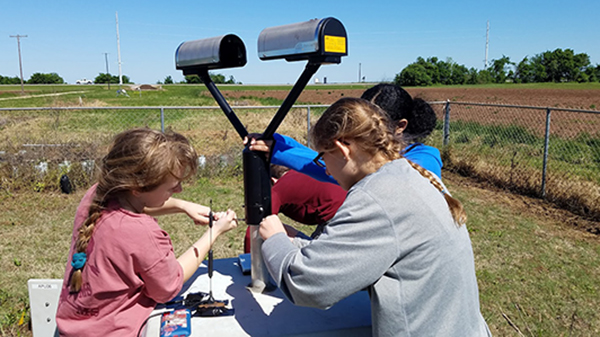Meteorology Undergraduates Maintain NASA Research Instrument
The NASA disdrometer will be used to investigate rainfall in the region.
Nov 18, 2019

Undergraduate students Rachel Eldridge, Leanne Blind-Doskocil, and Erin Sherman (L to R) assembling the disdrometer. (Photo courtesy of Dr. Don Conlee.)

Undergraduate students Lance Belobrajdic and Rachel Eldridge checking the disdrometer’s control panel. (Photo courtesy of Dr. Don Conlee.)
In April, NASA scientists requested that Texas A&M University's Department of Atmospheric Sciences host one of their instruments to measure rainfall in Southeast Texas.
The disdrometer, an instrument that can determine the size of raindrops and characterize other types of precipitation, can be used to create data sets that will be applicable to research including severe weather and climate change.
Dr. Don Conlee, instructional professor of atmospheric sciences, and his undergraduate student research group, the Observations Directed Studies Group, were tasked with installing, learning about, and maintaining the device.
To make sure that NASA satellites are accurately characterizing precipitation from space, they “need to have a diverse set of surface installations in different regimes, and different climate locations,” he said.
Using a laser-based system, the disdrometer counts the number of drops based on their size and allows for the scientists to characterize precipitation far more completely than a traditional rain gauge can.
In conjunction with the data from the radar on top of the Eller Oceanography and Meteorology Building (the ADRAD), the students can look at significant weather events and compare them to events in the past.
Learning Real-Life Research Skills
The students are learning the importance of calibration and validation, as they take the instrument and test it to ensure that it’s seeing the right thing, Conlee said.
As for Conlee, he hopes to continue involving undergrads in research with observational technologies to help them increase their understanding of data and thus their skill set for future endeavors in both academia and the workplace.
“It’s easy to lose sight of how messy real data are, and through this, they see how hard it is to keep and maintain a high-quality data set,” he said.
Rachel Eldridge is a junior meteorology major who was a local associate member of Dr. Conlee’s Research Experiences for Undergraduates (REU) summer 2019 cohort. She was tasked with “taking the raw data from the disdrometer, breaking it apart to look at each parameter, and then graphing it to understand what’s going on,” she said.
Conlee explained that for now, her research is to continue to learn about what the instrument is capable of, refine how to read it in a scientific sense, and implement quality control algorithms. Eldridge is also looking at recent heavy rainfall events to characterize the precipitation and will present her research in Boston in January 2020 at the American Meteorological Society meeting.
The real-world application of skills learned in the classroom help prepare the students for the science field, seeing and working with real data.
Through this field research, students gain experience in doing observations, maintaining equipment, coding, and getting communications in and out. To see live weather data, check out information from the Texas A&M Research Farm and the disdrometer hosted on the NASA site.
To help create more complete data sets, they are hoping to install more observing stations on campus, including the Texas A&M Gardens on West Campus and to reinstall the green roof station on the roof of the Langford Architecture Building following roof repairs.
Dr. Courtney Schumacher, professor of atmospheric sciences, was instrumental in arranging the NASA collaboration and is also currently using disdrometers for her research.
By Amanda Hoth '21

